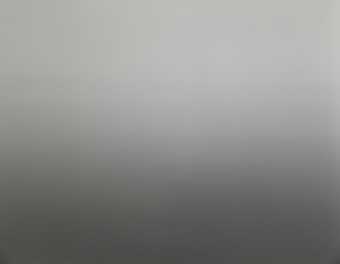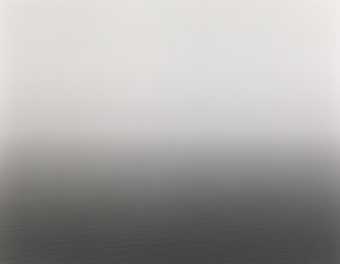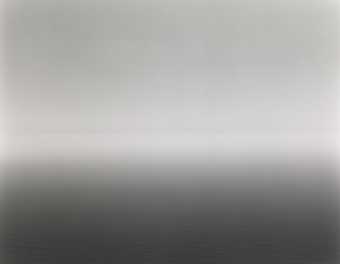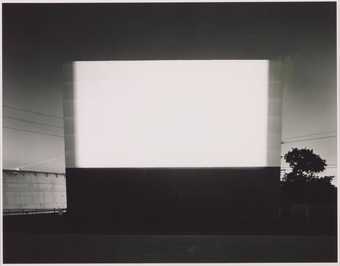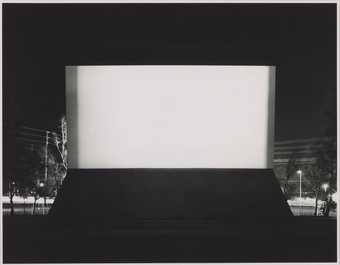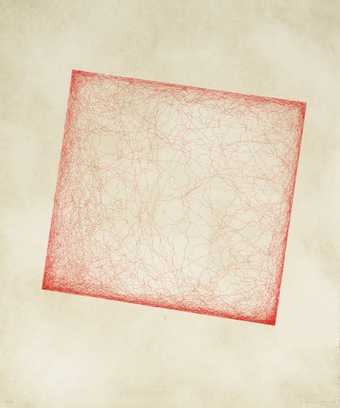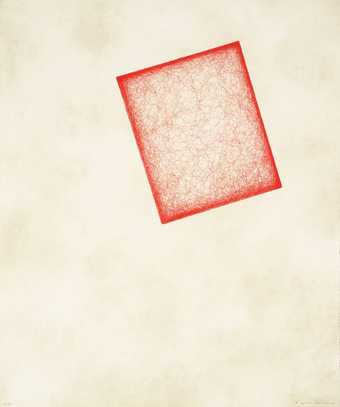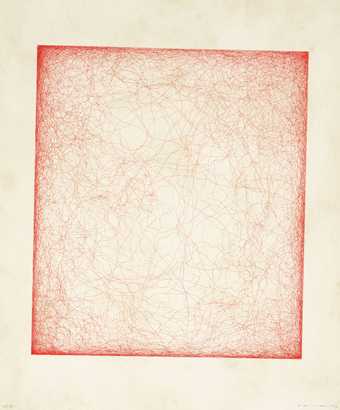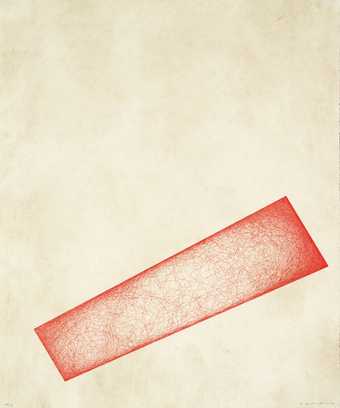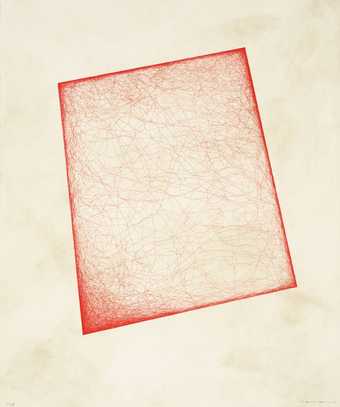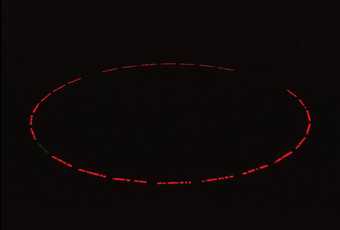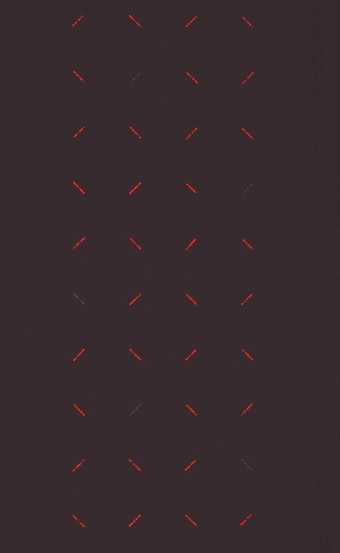
Not on display
- Artist
- Yukinori Yanagi born 1959
- Medium
- 49 perspex boxes, plastic tubes and artificial sand
- Dimensions
- Displayed: 2820 × 4050 × 18 mm
- Collection
- Tate
- Acquisition
- Purchased 1998
- Reference
- T07464
Summary
Pacific is a large installation comprising forty-nine plastic boxes arranged in a rectangular grid on the wall and connected using vinyl chloride resin tubes. Each box contains a representation of a national flag made from synthetic, coloured sand that has a dry and coarse appearance. Pacific was produced in its present form by allowing a large number of ants to move through the boxes, creating tunnels in the sand that have produced cracks across the faces of the flags, and the bodies of some of the dead ants are still present in several of the boxes. The flags all represent countries that border the Pacific Ocean, nations that once had colonies which lay on those borders, or indigenous groups that live in such areas but do not have sovereignty over any territory (for instance, the Maori of New Zealand). Each box measures 300 x 450 x 17 mm and there is a gap of 120 mm between the boxes in the vertical rows and 150 mm between those in the horizontal rows. The boxes are backed onto a cast acrylic resin board and each has two tubes emerging from its top and bottom edges, as well as one from either of its sides. The tubes that project from the edges of the outermost boxes on all four sides of the installation are blocked up by means of plugs.
This work was made by the Japanese artist Yukinori Yanagi in 1996, when he was primarily living and working in New York but was also travelling to Japan regularly. Yanagi produced a number of sketches during the process of planning the work. Each flag has a designated position in the grid and Yanagi had all of the boxes and tubes fabricated according to his own instructions. Yanagi produced the flag patterns inside the boxes himself with a type of gardening sand called perlite, which he coloured with dried pigment. During the work’s initial installation the boxes were placed on a temporary wall, behind which, visible to viewers, were feeding containers holding live ants. The ants were released into the boxes and were allowed to move through the installation over the course of the exhibition. Afterwards the feeding containers were removed and Yanagi used a spray adhesive to fix the sand permanently in place. Yanagi has supplied Tate with a video documenting the making of Pacific, including the movements of the ants, and although this is not part of the work it can be displayed alongside it.
Pacific is one of many installations that Yanagi has made since 1990 in which their compositions are altered by ants moving between sand-filled plastic boxes, several of which also involve depictions of national flags (see, for instance, The World Flag Ant Farm 1990, Benesse House, Naoshima Contemporary Art Museum, Naoshima). Here, the title Pacific acts as a seemingly neutral reference to a geographical region, yet through the co-presence of flags representing recognised nations, former colonial powers and indigenous peoples, the work acknowledges the contestation of territorial authority and national identities that characterises the area’s history. Yanagi has made more explicit references to geopolitical conflict in works such as 38th Parallel (North Korean and South Korean Flag) 1991 (Hara Museum, Shinagawa), a similarly ant-farm-like installation that combines the flags of two nations which have a particularly hostile relationship.
Discussing Pacific in 1996, Yanagi stated that ‘Through my work I expose movement and transportation’ (Yanagi 1996, unpaginated). In light of this, the ants’ lines of movement between and across the depicted flags in this installation could be taken to suggest the migration of people between different nations, especially given Yanagi’s own status as an Japanese emigré who often travelled between his home country and America. In 2003 Yanagi said that his works involving ants and national flags are designed to suggest that ‘Nations, ethnicities, religions are all ghettos. They are surrounded by imaginary boundaries born out of social or institutional constructs’ (Yanagi in Trujillo 2003, p.243) and that when the ants erode the clear boundaries between the flags in these works, this serves as ‘a simple, equal and hopeful way of expressing the gradual unification of all the world’s nations’ (Yanagi in Trujillo 2003, p.240).
Further reading
Wandering Position: Yukinori Yanagi, exhibition catalogue, Benesse House, Naoshima Contemporary Art Museum, Naoshima 1992.
Yukinori Yanagi, ‘Statement’, 1996, unpaginated, Tate Acquisition File, Yukinori Yanagi, PC10.1.
Ernesto Trujillo, ‘Obeying Ants’, in Linda Weintraub, In the Making: Creative Options for Contemporary Art, New York 2003, pp.236–43, http://www.ernestoatrujillo.com/PDF/yyreading.pdf, accessed 30 April 2015.
David Hodge
April 2015
Supported by Christie’s.
Does this text contain inaccurate information or language that you feel we should improve or change? We would like to hear from you.
Display caption
Yanagi filled a series of interconnecting Perspex boxes with coloured sand to represent the flags of 49 nations. These include nations bordering the Pacific, former colonial powers, and native populations without sovereign territories such as the Maoris and Aborigines. He then released thousands of ants, whose movement distributed the sand from one flag to another. Suggestive of patterns of global migration, the ants gradually eroded the borders between different nations, creating new designs. ‘I question the concept of a nation’, Yanagi has said. ‘A nation, its border and national flag, has become an imaginary fiction.’
Gallery label, November 2006
Does this text contain inaccurate information or language that you feel we should improve or change? We would like to hear from you.
Explore
- emotions, concepts and ideas(16,416)
-
- formal qualities(12,454)
-
- fragmentation(233)
- universal concepts(6,387)
-
- history(1,983)
- transformation(186)
- religious and ceremonial(1,733)
-
- flag - non-specific(333)
- countries and continents(17,390)
- social comment(6,584)
-
- colonialism(429)
- nationalism(2,020)
You might like
-
Hiroshi Sugimoto El Capitan, Hollywood
1993 -
Hiroshi Sugimoto Tyrrhenian Sea, Scilla
1993 -
Hiroshi Sugimoto Aegean Sea, Pilion
1990 -
Hiroshi Sugimoto Ligurian Sea
1993 -
Hiroshi Sugimoto Rosecrans Drive-in, Paramount
1993 -
Hiroshi Sugimoto Winnetika Drive-in, Paramount
1993 -
Yukinori Yanagi [title not known]
1997 -
Yukinori Yanagi [title not known]
1997 -
Yukinori Yanagi [title not known]
1997 -
Yukinori Yanagi [title not known]
1997 -
Yukinori Yanagi [title not known]
1997 -
Cornelia Parker CBE RA Cold Dark Matter: An Exploded View
1991 -
Tatsuo Miyajima Opposite Circle
1991 -
Tatsuo Miyajima Lattice B
1990 -
Tomoko Takahashi Drawing Room
1998


